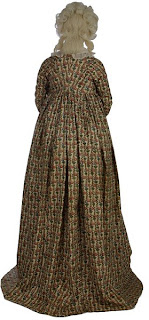This is also the point where I'm going to stop categorizing everything the same way as before. At least for this five year period, there are too many options.
Sleeves: Long, just above elbow, or short. All fitted.
Bodice front: Gathered on cord, crossed, or low under bust.
Bodice back: Small diamond shape, some with numerous small pleats.
Skirt: Open and Closed. Sometimes gathered in front. Pleated in back, very small up to large box pleats.
Length: Trains common for evening and some afternoon.
Waist: Some natural waists still seen, most at underbust.
Fabrics: Cotton and silk most common. Small repeated prints and solids.
MFA Silk Round Gown, late 1790s
Met Cotton Print Gown, 1795
V&A Cotton Print Gown, 1795-1800
V&A Cotton Print Gown, 1795-99
Met Silk Open Robe, 1797
V&A Cashmere Shawl Gown, 1797
Met Cotton Print Gown, 1798
Met Silk Open Robe, 1798
Characters in High Life, 1795
Everybody Out of Town, 1796
The Gallery of Fashion, 1796
A Promenade, 1797
Beauty and Fashion, 1797
The Graces Comparing Sandals, 1798
The Family Party, 1799
Transparent Pieces, 1799



























"This seems to be a crazy time period." Well, it was the middle of the French Revolution after all!
ReplyDeleteDear Nicole,
ReplyDeleteI came to the same conclusion: it was a massive shift and everything went kerplooie. Rather reminds me of the shift in the mid to late 1960s: after centuries of gloves and some level of formality, it was hot pants and maxi skirts, wacked-out shoes and bare feet, beehives and unwashed hair, vinyl clothes and bra-less cottons. All part of massive shifts in social patterns, and all during a bitter war.
Thanks especially for the print titled "Beauty and Fashion". There's a chiffonet under construction in it and the plume being sewn on with a needle and thread! I've just finished a chiffonet and now have some more evidence about potential original construction methods.
Thanks again,
Natalie
What a wonderful post!
ReplyDeleteDear Nicole,
ReplyDeleteThank you so much for this post...
...and "Hurrah" for the dawn of the timespan of one of the most exciting and yet fairly underestimated fashion eras!
Unfortunately some still regard this era as boring or plain, but have they ever delved into the variety of sewing technics, patterns, cuts, fabrics and important attention to detail?
Please have a closer look at the different fashion plates and extant garments before judging! Because almost everythig was possible! (...and honestly is that anywhere close to boring or plain???)
Sabine